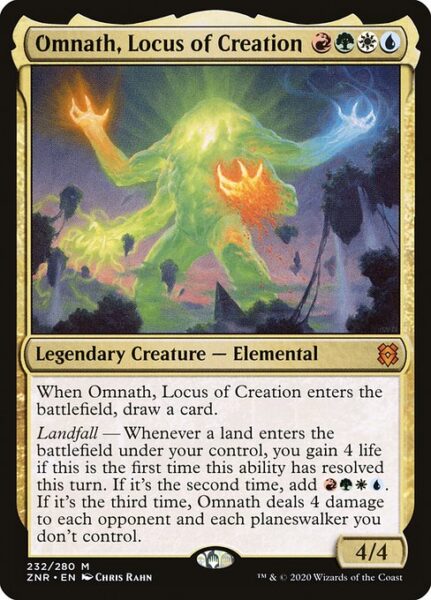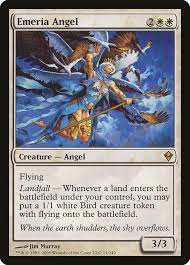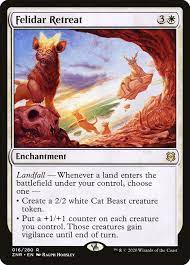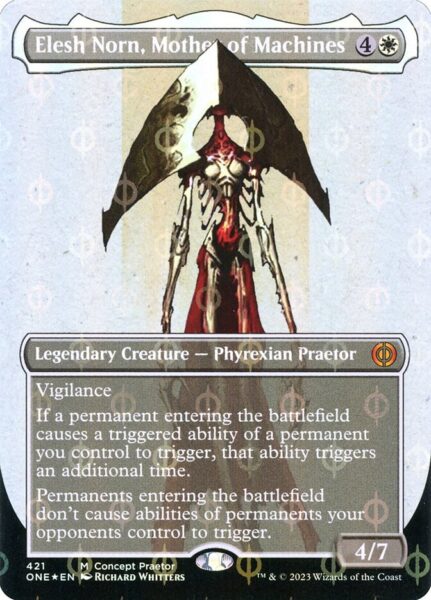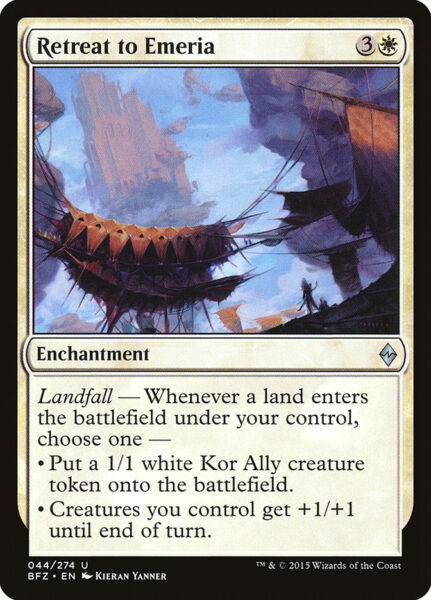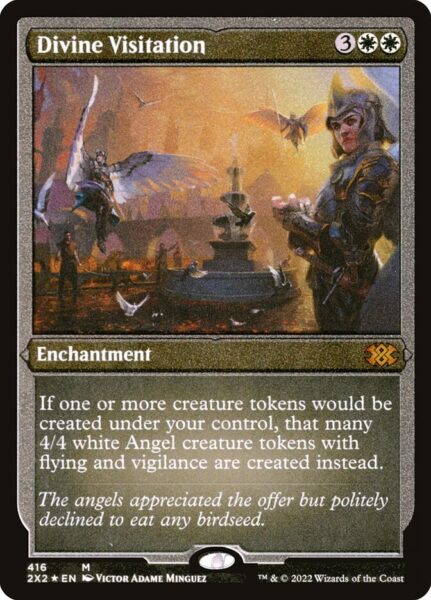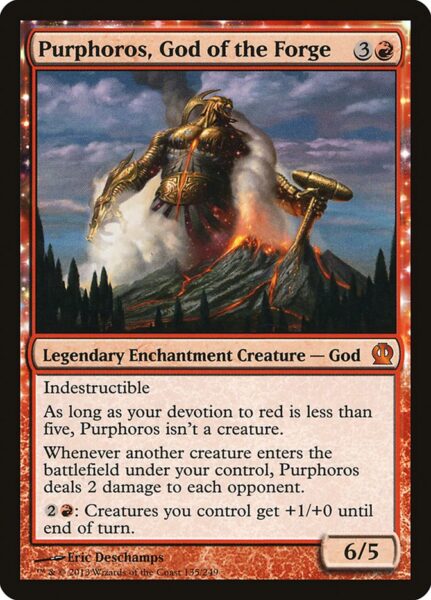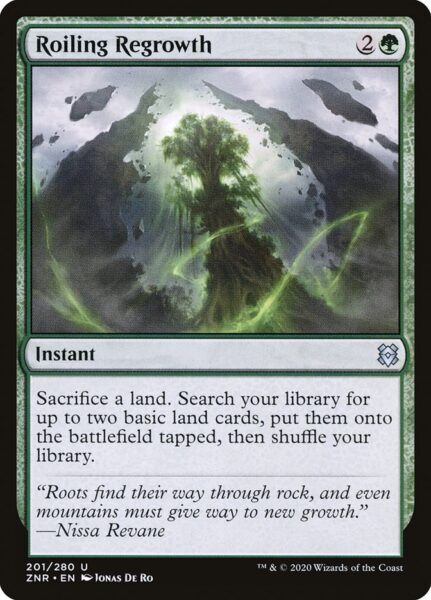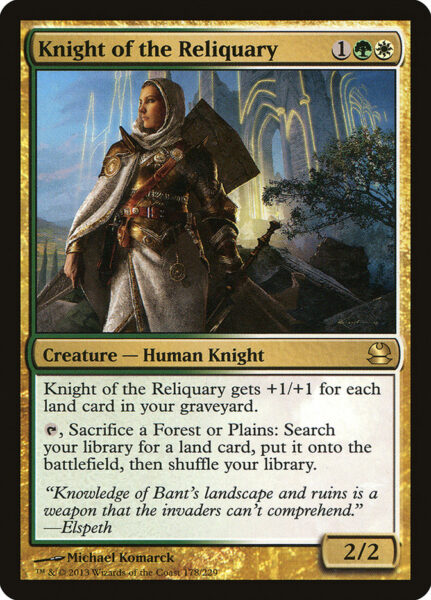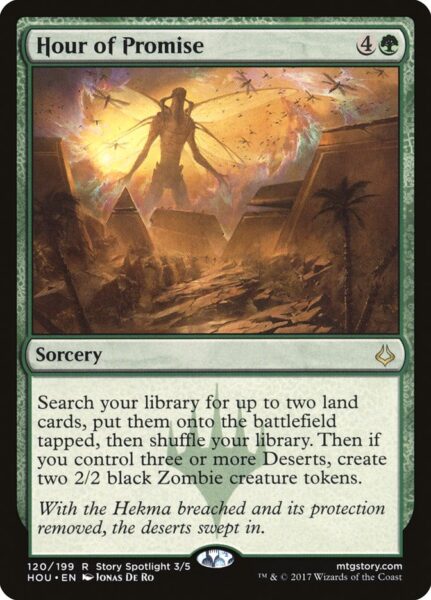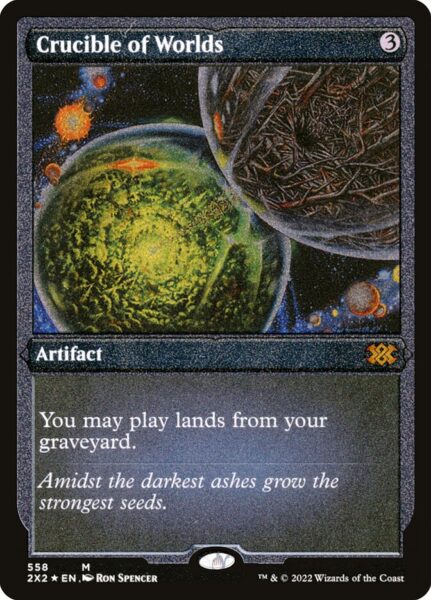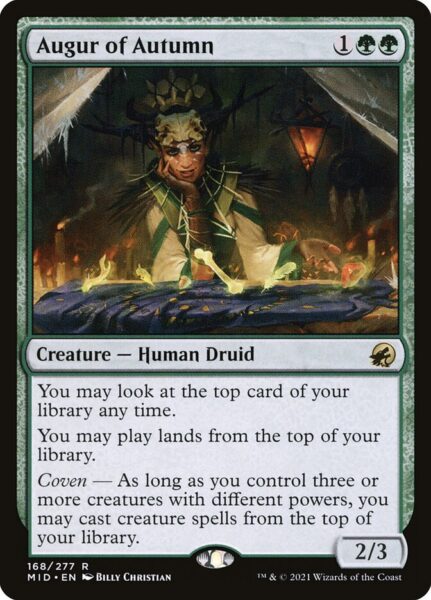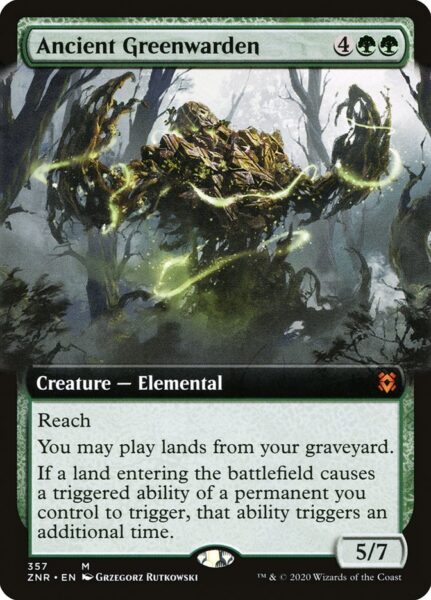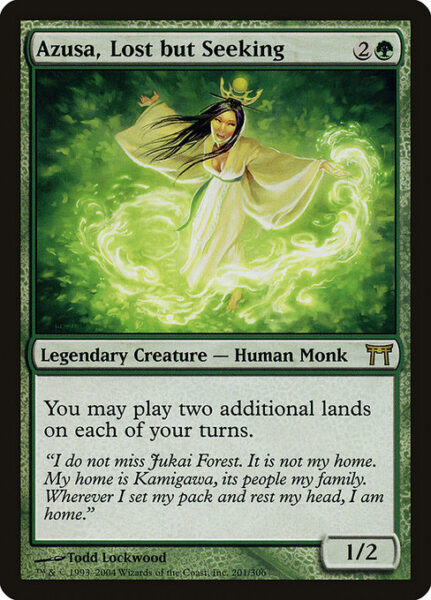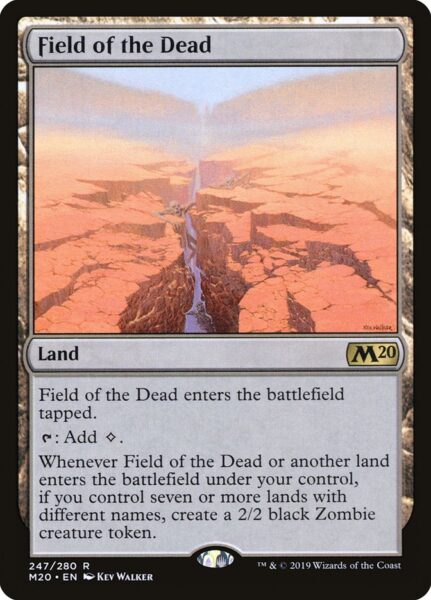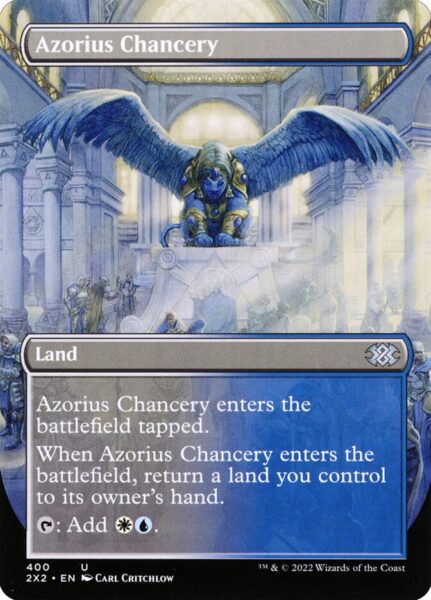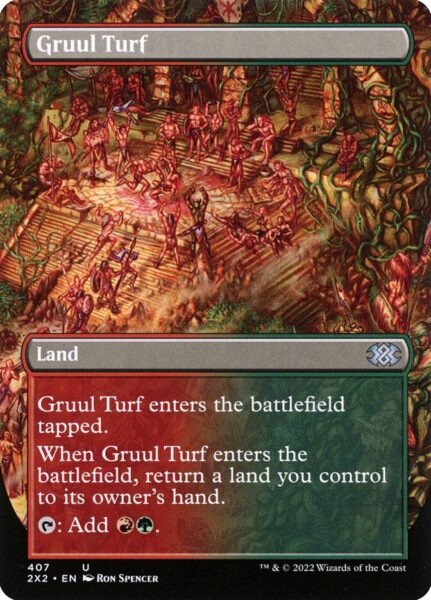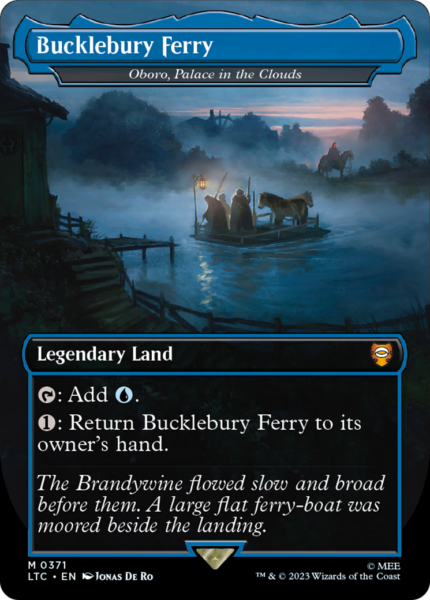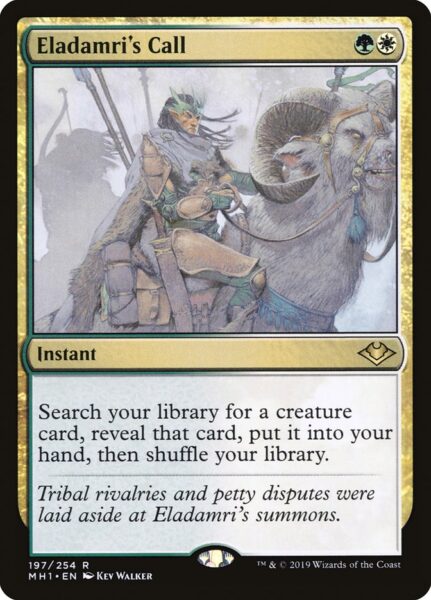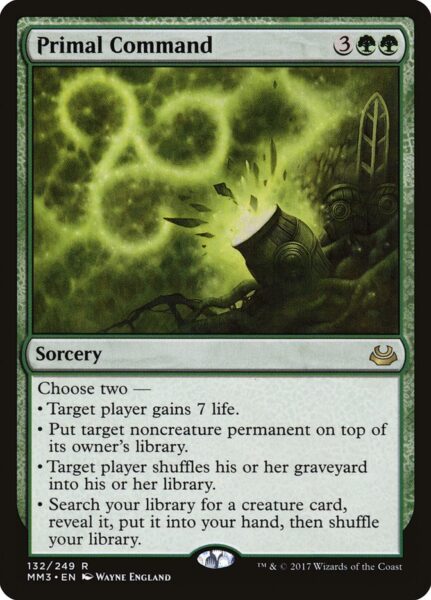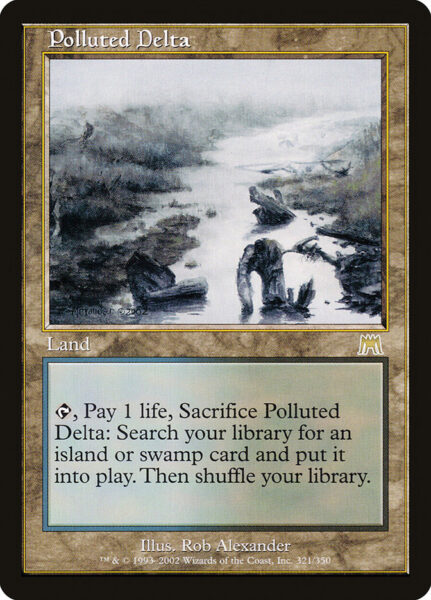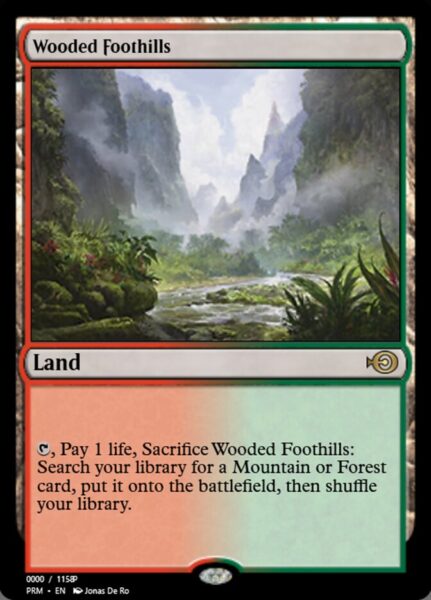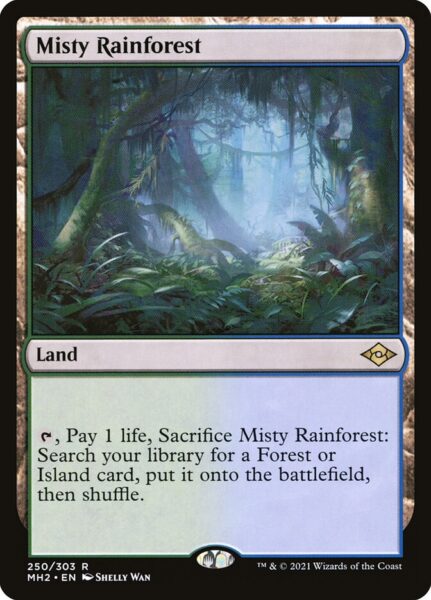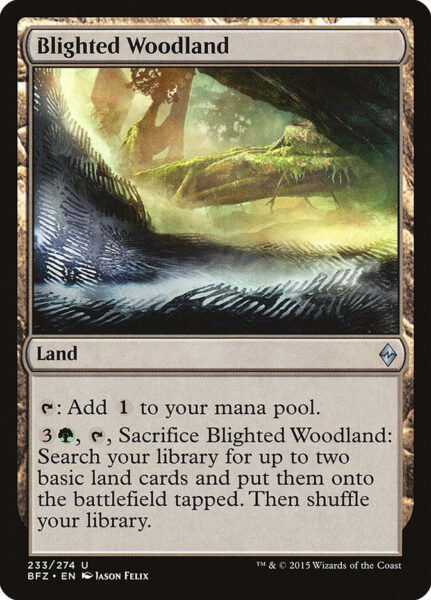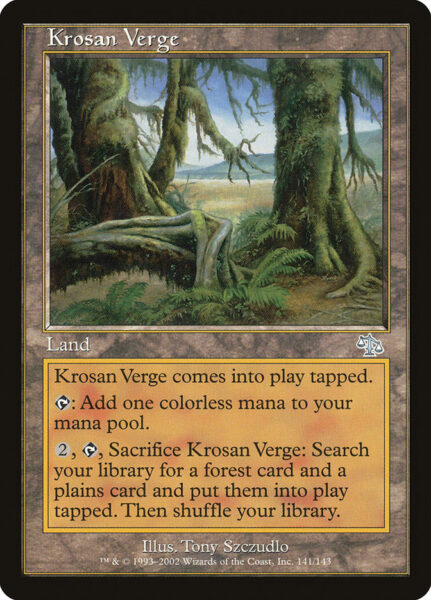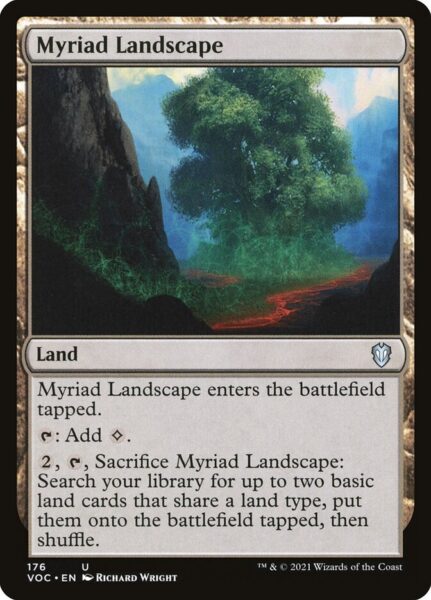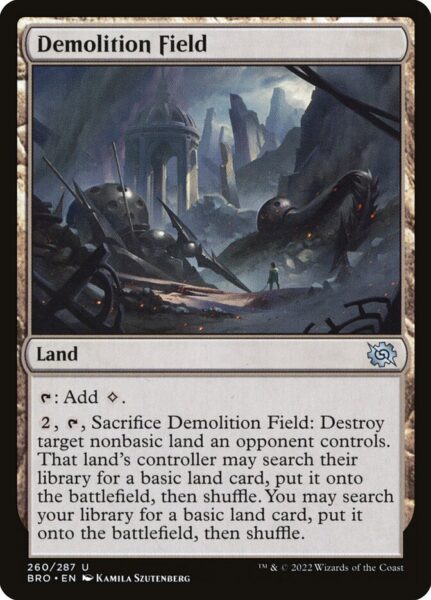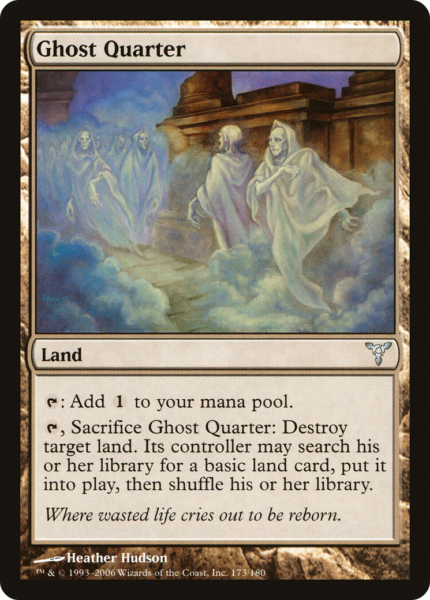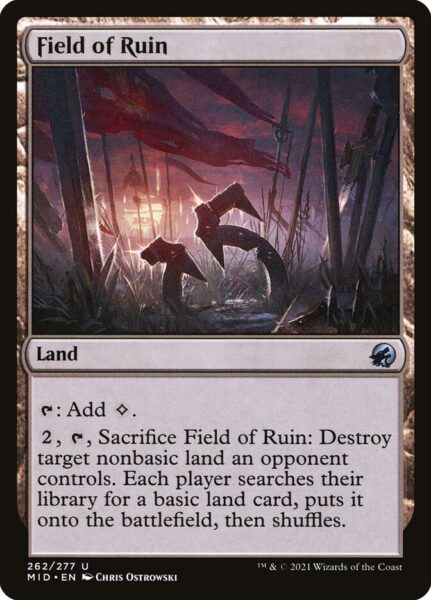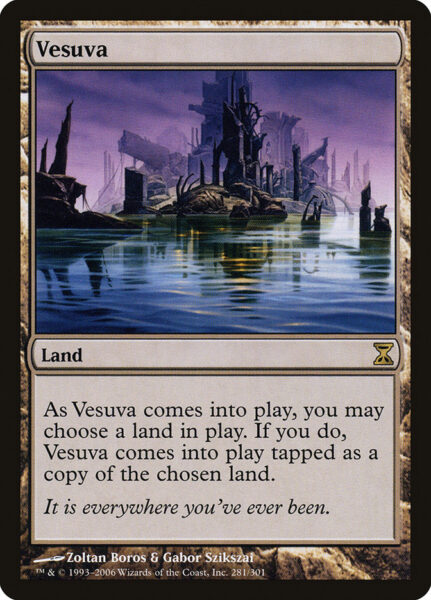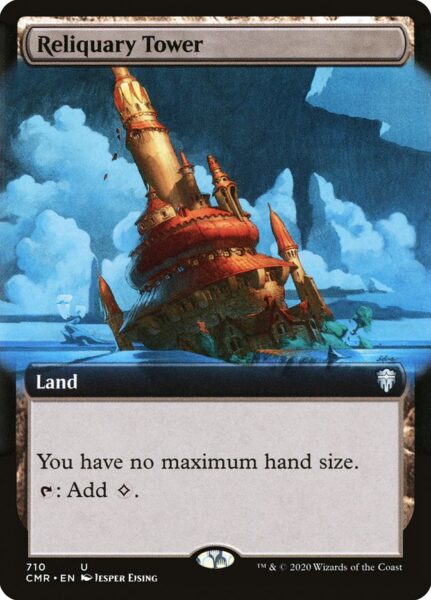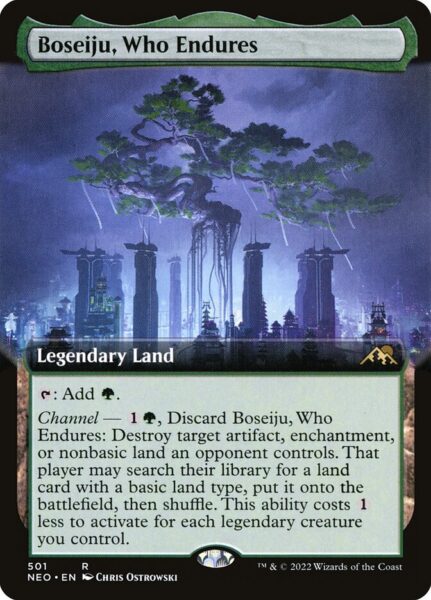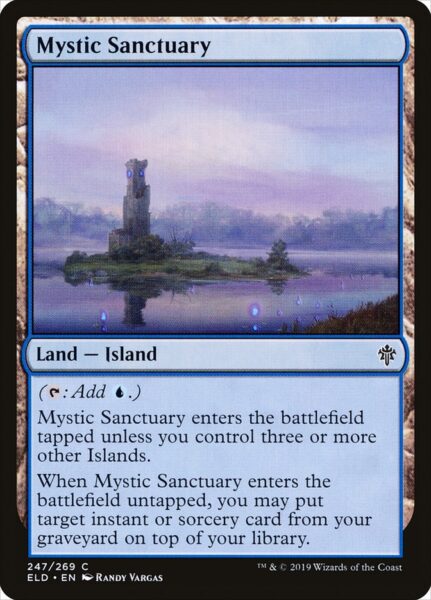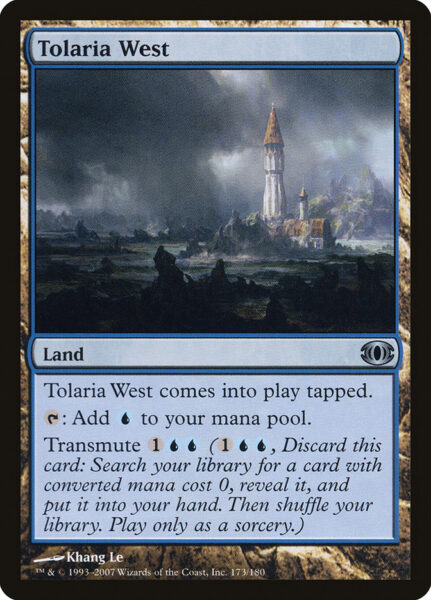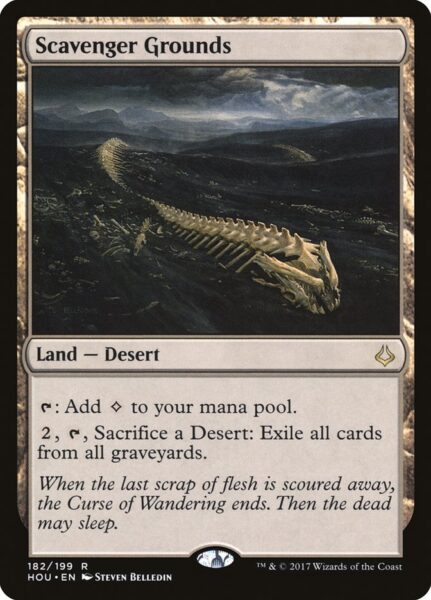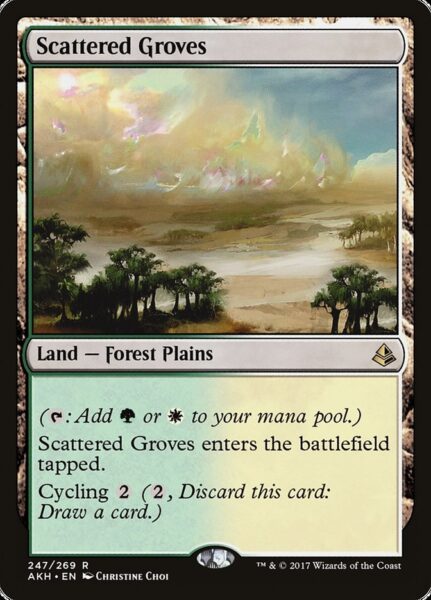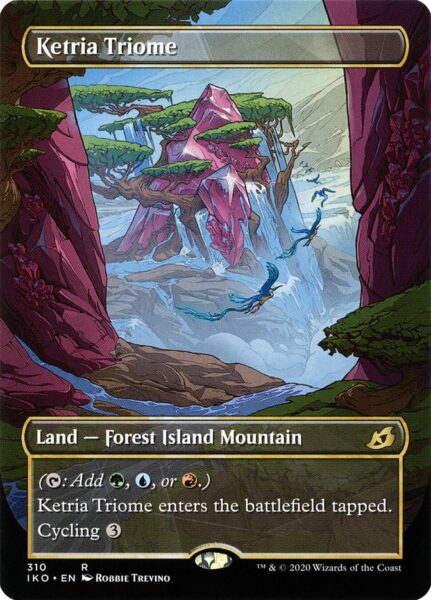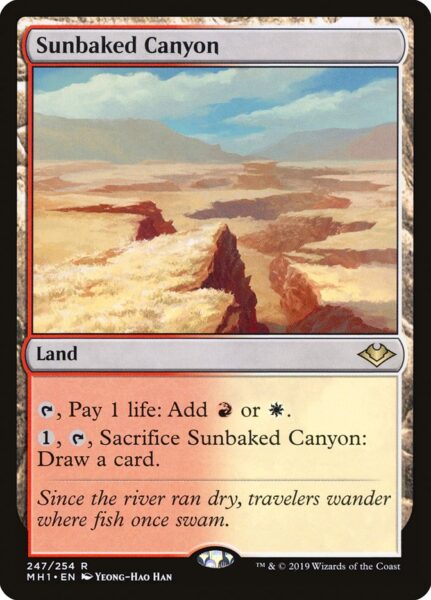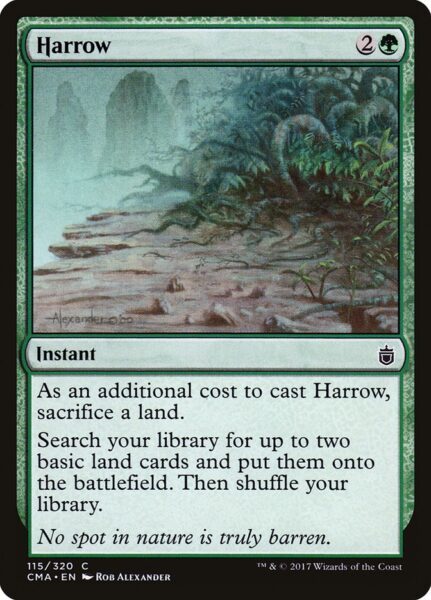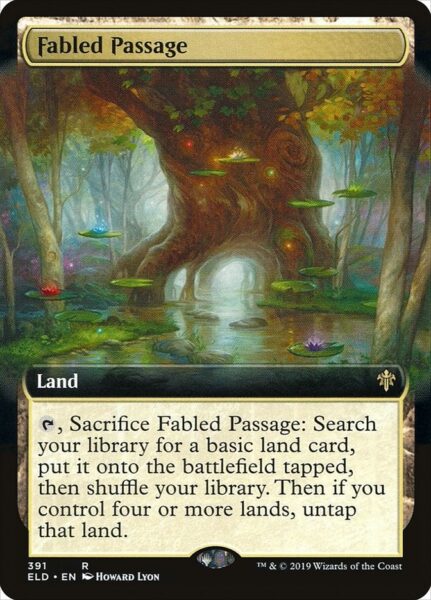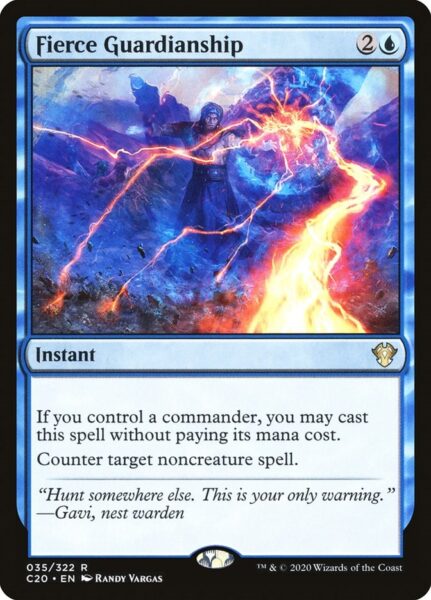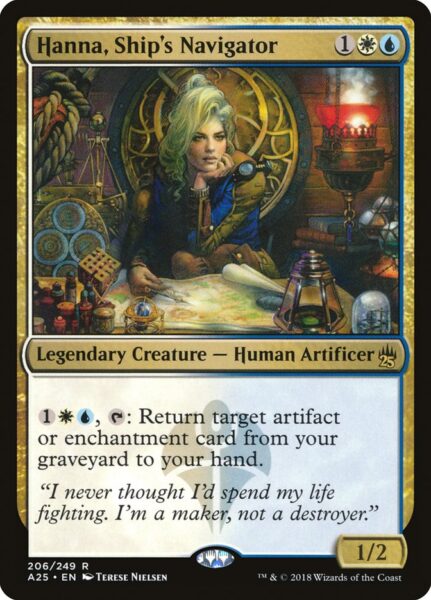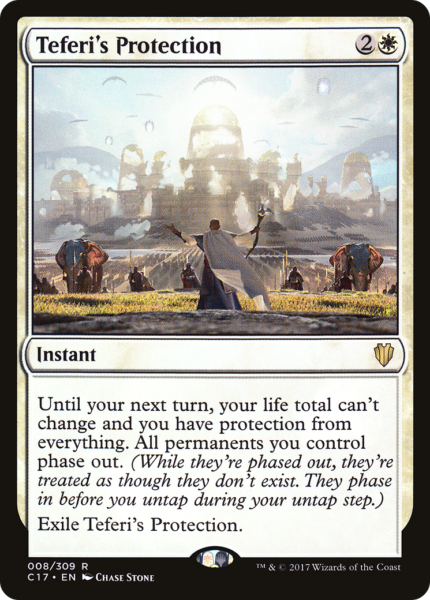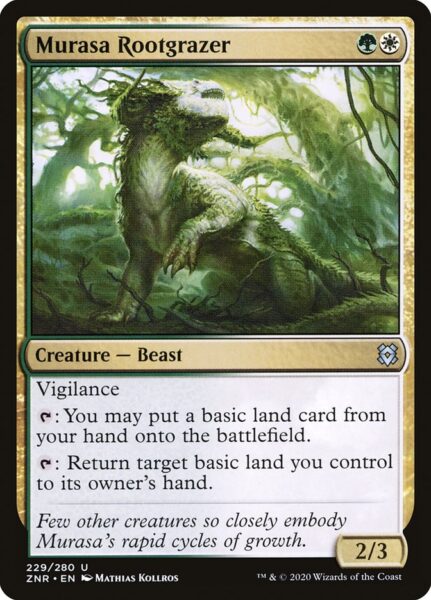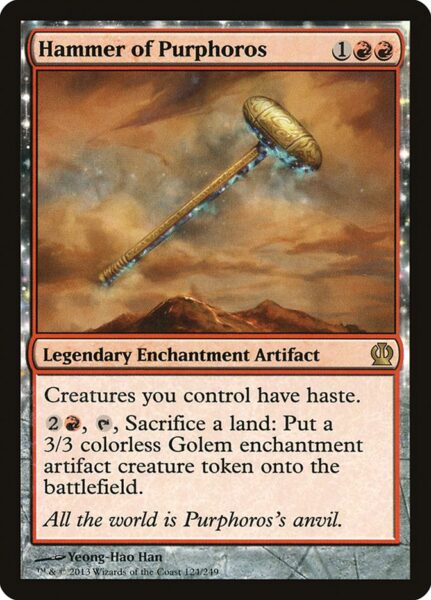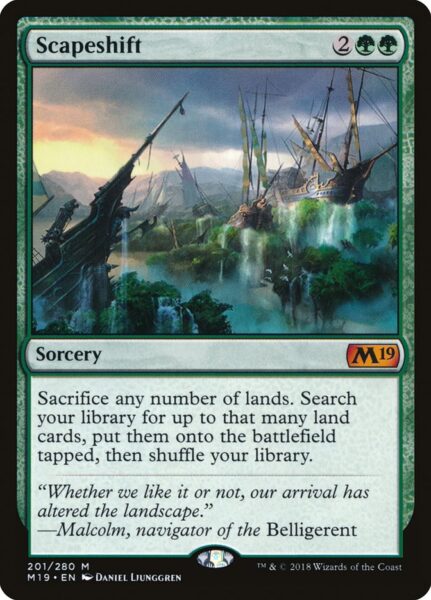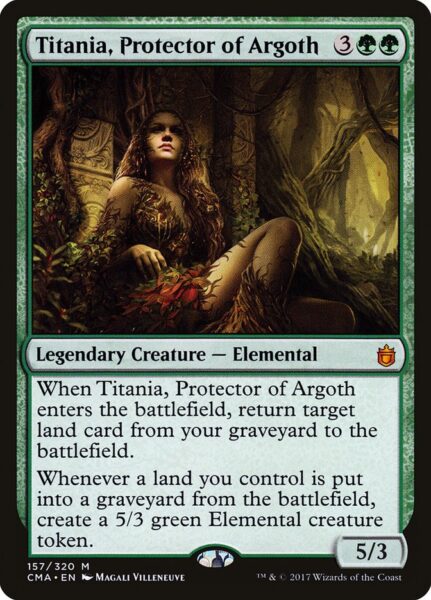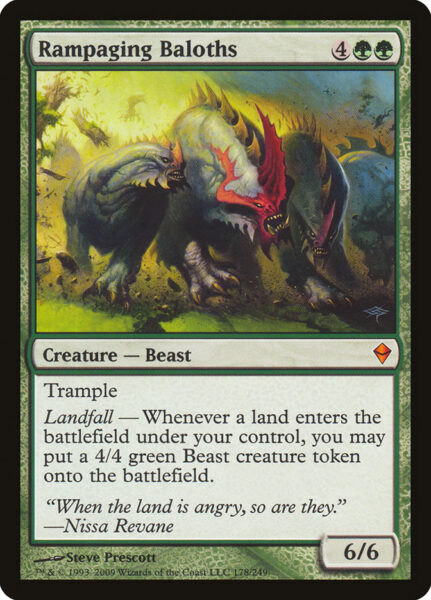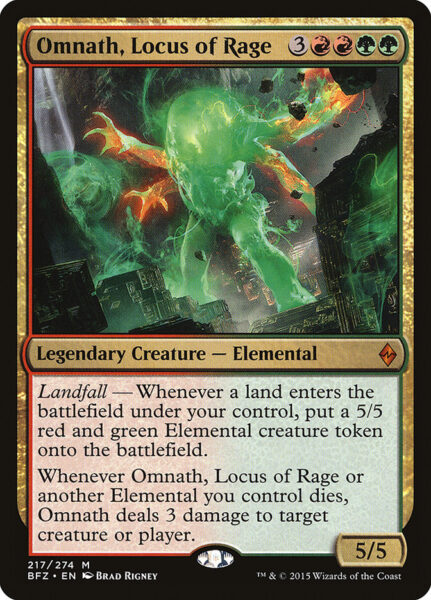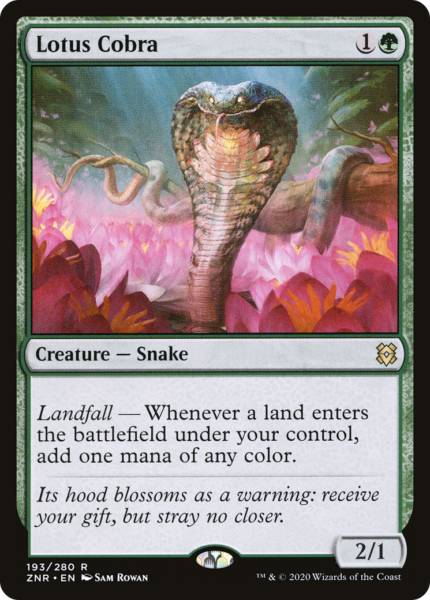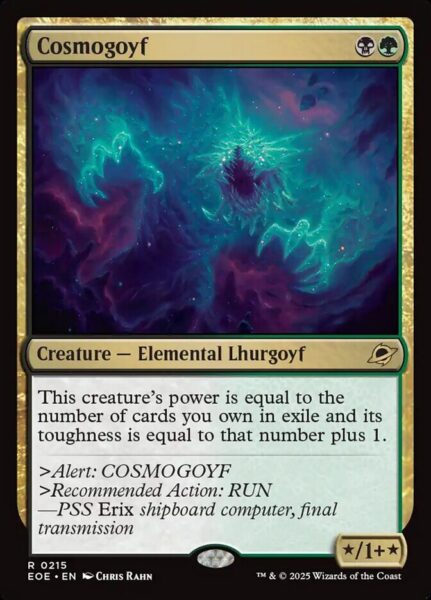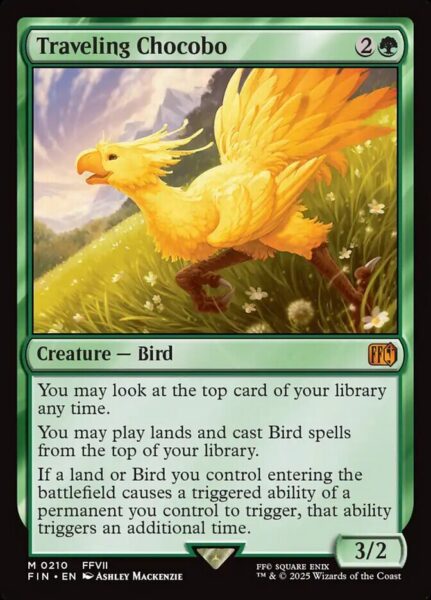Ever thought Omnath, Locus of Creation was too busted for Standard? Modern? Well, wait until you see the Elemental in action in Commander! Want to make infinite mana? We can do that! Want to mill your opponent out in a single turn? Also a possibility. Want to make an unlimited number of hasty flying Angels and grow them an infinite amount? Keep reading!
Decklist – 4-Color Landfall Combo with Omnath Locus of Creation
| Omnath, Locus of Creation |
Creatures (30)
| Hedron Crab | |
| Ruin Crab | |
| Sakura-Tribe Scout | |
| Llanowar Scout | |
| Lotus Cobra | |
| Augur of Autumn | |
| Azusa, Lost but Seeking | |
| Courser of Kruphix | |
| Dryad of the Ilysian Grove |
Planeswalkers (1)
| Wrenn and Six |
Artifacts (1)
| Crucible of Worlds |
Enchantments (6)
| Exploration | |
| Retreat to Coralhelm | |
| Felidar Retreat | |
| Retreat to Emeria | |
| Divine Visitation | |
| Zendikar’s Roil |
Instants (9)
| Enlightened Tutor | |
| Worldly Tutor | |
| Eladamri’s Call | |
| Chord of Calling | |
| Deflecting Swat | |
| Fierce Guardianship | |
| Harrow | |
| Roiling Regrowth | |
| Teferi’s Protection |
Sorceries (8)
| Banefire | |
| Life from the Loam | |
| Far Wanderings | |
| Skyshroud Claim | |
| Splendid Reclamation | |
| Tempt with Discovery | |
| Hour of Promise | |
| Primal Command |
Lands (44)
Arid Mesa
Azorius Chancery
Blighted Woodland
Bloodstained Mire
Boros Garrison
Breeding Pool
Boseiju, Who Endures
Fabled Passage
Field of the Dead
Field of Ruin
Flooded Strand
Gruul Turf
Hallowed Fountain
Izzet Boilerworks
Krosan Verge
Marsh Flats
Misty Rainforest
Myriad Landscape
Oboro, Palace in the Clouds
Polluted Delta
Reliquary Tower
Sacred Foundry
Scalding Tarn
Selesnya Sanctuary
Simic Growth Chamber
Steam Vents
Stomping Ground
Temple Garden
Verdant Catacombs
Vesuva
Windswept Heath
Wooded Foothills
Yavimaya, Cradle of Growth
Forest (3)
Island (2)
Mountain (3)
Plains (3)
Deck Tech
Primary Game Plan
This is a combo deck looking to abuse Omnath, Locus of Creation and other cards with landfall, a mechanic Wizards first put a name to in the original Zendikar Block (https://draftsim.com/landfall-mtg/). We have at least 6 different ways to win using landfall that I will explain shortly. In order to accomplish this goal, we want to trigger landfall as many times as possible in a single turn. With this in mind, our deck can be divided into a few parts, each of which furthers this goal on the path to victory: cards with landfall; win conditions that combo with these cards; and ways to play multiple lands in a given turn. The rest of the deck is made up of ways to find, protect, or recur our combo pieces.
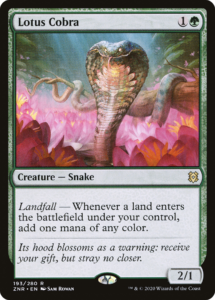
Landfall Cards
These are the cards that are essential to our combo. Without them, we are just making a lot of land drops and hoping to win fairly through combat with underpowered creatures. These cards can, in theory, win the game without our big win conditions, but they will do so more slowly and, in a format as powerful as Commander, more often than not won’t.
Emeria Angel – gives us a 1/1 flier for each land on a 3/3 body with flying. The evasion is important, both in protecting our life total during the early game and giving us a way to close the game out quickly once we find other pieces.
Felidar Retreat – one of those other pieces, growing our entire team with each land when we routinely make 2-3 land drops in a single turn (frequently more) will give us a lethal army quickly.
These two cards exemplify the kind of simple, yet powerful, synergies of this deck. As mentioned, we routinely make 3-5 land drops in a single turn and with just these two landfall cards on the battlefield, we can go from having no army to having 5 flying bird tokens, each bigger than the one after (the first token will be a 2/2, the second will grow the first and itself, so that we have a 2/2 and a 3/3, and so on for as many land drops as we make).
Hedron Crab – one of our win conditions all by itself. I was playing Mill in Modern before it became a legitimate strategy and so I have a special place in my heart for the crab.
Lotus Cobra – one of our best landfall cards, Lotus Cobra is the engine behind some of our fastest and most powerful starts. Getting mana for each land drop gives us the ability to do many busted things, assuming we don’t run out of gas along the way.
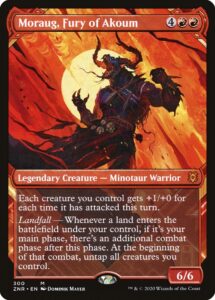
Moraug, Fury of Akoum – one of our late-game finishers, this minotaur gives us multiple (infinite) combats with the right support cards. He usually needs an army to be lethal, but even all by himself, he can get there on the right board. The only tricky part about Moraug, Fury of Akoum is we need to make our land drops during our second main phase if we want to attack during our regular combat phase on top of the additional combat phases Moraug’s ability gives us (citation: https://gatherer.wizards.com/Pages/Card/Details.aspx?multiverseid=495196). If we make our land drops in our first main phase, after our extra combats, our creatures will stay tapped for our main combat and we won’t be able to attack with them. If we make our land drops during our second main phase, our creatures will untap before attacking during the extra combat phase(s). We will then move immediately to the end step after the extra combats.
Nissa, Resurgent Animist – a new addition, Nissa is a 1-shot Lotus Cobra, who also tutors up one of our combo pieces. We play 4 elves and 1 elemental, each of which supports our plan of playing as many lands as possible every turn. It’s true we don’t get to choose which one we get, but any of them will do what we are chiefly interested in doing.
Omnath, Locus of Creation – is a busted, busted Magic card, as anyone who has played with or against it in Modern knows. We mostly care about his second landfall trigger, as it gives us 4 mana to use towards doing more fun and broken things, but the 4 damage from his third landfall trigger gives us a way to burn our opponent out if they’ve shut down combat somehow.
Retreat to Coralhelm – filtering our draws with each land drop is great, but what we really want to do is make infinite land drops using this card, a bounce land, and either Llanowar Scout or Sakura-Tribe Scout (thank you Saffron Olive for this great idea: https://www.mtggoldfish.com/articles/against-the-odds-infinite-landfall-mogaug-modern). If getting between 1 and 3 landfall triggers a turn is enough to get ahead in a game, making as many as we want should be game-ending.
Retreat to Emeria – a worse Felidar Retreat, it will still be enough to win us the game when we go off.
Ruin Crab – thank you to whomever at Wizards decided Magic needed another Hedron Crab. This one mills each opponent and can’t target ourselves, in case we’re trying to get more lands in the yard to bring back with Splendid Reclamation.
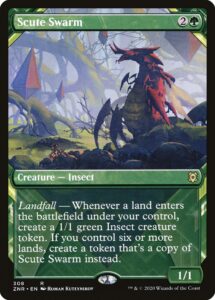
Scute Swarm – as a former Russian literature professor, math is not my strong suit, but this card gets out of hand real, real quick once we control 6 or more lands. The sixth land makes a second copy of Scute Swarm. The seventh land is seen by both copies and thus each triggers once, giving us 2 more copies of Scute Swarm. The eighth land is seen by 4 copies, thus giving us 4 more copies. The ninth land is then seen by 8 copies, giving us 8 more. In sum, the number of Scute Swarm doubles with each landfall trigger starting with our sixth. Correct me in the comments if I’ve got it wrong!
Tatyova, Benthic Druid – gains us life and digs for our finishers. This merfolk druid is crucial in moving us from making a lot of dorks to winning the game by allowing us to draw into whatever combo piece we’re missing.
Tireless Tracker – a landfall creature without the keyword, each land drop turns into a Clue.
Zendikar’s Roil – another way for us to make a bunch of tokens.
Honorable Mention
Elesh Norn, Mother of Machines – while lacking the landfall mechanic, she doubles each trigger from our other landfall cards. I don’t even want to think about how many tokens of Scute Swarm will get made with Mom on the battlefield…On a related note, she also completely shuts down what we’re trying to do if our opponent resolves her.
Ideally, we want 2 or 3 of these cards on the battlefield before we try and combo off. Getting incremental value from any of these will frequently help us survive the early game, but for us to turn a corner, we need one of our finishers, as well as one of our ways of making more than one land drop a turn. Playing fairly is not what Omnath, Locus of Creation is about.
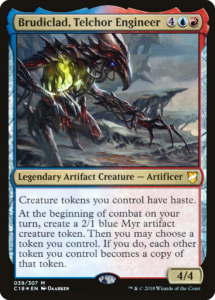
Win Conditions
Banefire – what better use of our infinite mana than an unstoppable burn spell for unlimited damage?
Brudiclad, Telchor Engineer – we need a way to give all the tokens we make in any given turn haste and this 6-drop does that, while also allowing us to make all of our tokens a copy of our best (or most evasive) token. It’s possible a card like Hammer of Purphoros is just better here, but the flexibility this card gives us, plus it’s own token generation is why it’s earned a spot in our 99.
Divine Visitation – who wants 1/1 Kor Ally tokens when you can have 4/4 Angels.
Hedron Crab/Ruin Crab – with the number of land drops we can make with this deck, it’s not difficult to mill our opponent out if we have both crabs on the battlefield.
Moraug, Fury of Akoum – as detailed above, this minotaur warrior can win us the game by both pumping our team and giving us multiple combat phases.
Now that’s a combo!
Purphoros, God of the Forge – my favorite win condition and one of my all-time favorite cards (and another reason to consider Hammer of Purphoros for the flavor win), the red God gives us a way to burn our opponent out when combat is off the table (or just too slow).
Whether it’s making a bunch of 1/1s and 2/2s and giving them haste, or pumping them with +1/+1 counters, or turning them all into 4/4 Angels, or shocking our opponent with each token that enters the battlefield, our win conditions need at least one of our landfall cards to win us the game and a way to make multiple land drops in a given turn. Making a 4/4 Angel token with flying and shocking each opponent will only get us so far if we’re playing fairly. Luckily for us, we aren’t…
Playing All the Lands
Making a single land drop in order to get a single landfall trigger is not what this deck is trying to do. Omnath, Locus of Creation incentivizes us to make at least three land drops in a single turn, while our other landfall cards only get better with each additional land we play. We have three ways to ensure we can make as many land drops as possible: 1. cards that straight up let us play more than one land in a turn from our hand; 2. cards that search up more than one land and put them directly onto the battlefield from our library; and 3. cards that let us play lands from the top of our library or graveyard.
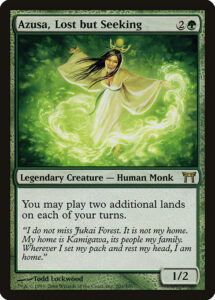
More than One Land Drop a Turn
This is by far our most powerful and effective way of abusing landfall triggers. The only drawback is we have to have lands in our hand to play or we can’t get value out of them. Most of these pieces also die to targeted creature removal and sweepers, making them more fragile than our enchantments.
Azusa, Lost but Seeking – lets us make a whopping 3 land drops a turn. Omnath, Locus of Creation‘s best friend.
Chulane, Teller of Tales – a powerful card that we could try to abuse more (Springbloom Druid, Borderland Ranger, and the like). However, even without building around him more, he is a powerful creature that is easy to get a ton of value out of.
Dryad of the Ilysian Grove – a great way to fix or mana or beat a Blood Moon!
Exploration – a difficult-to-deal-with and repeatable way to let us make multiple land drops a turn. Coming down on turn 1 can be game over.
Llanowar Scout – besides its combo ability, sometimes we just need to make another land drop for all of our various landfall triggers.
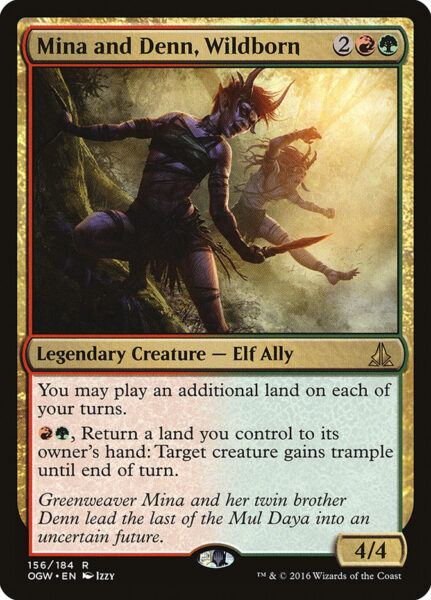
Mina and Denn, Wildborn – this pair solves one of the key problems with these cards: we run out of lands to play from our hand. The trample a creature gets is often just gravy, though it can be game winning in the right spot.
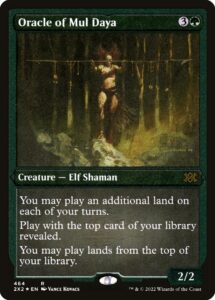
Oracle of Mul Daya – does two of the three things we want from this category of cards: lets us play additional lands and lets us play lands from the top of our library.
Sakura-Tribe Scout – a 1-mana Llanowar Scout for all intents and purposes.
Uro, Titan of Nature’s Wrath – one of the most busted cards printed in the last several years and it didn’t even come from Throne of Eldraine. This card isn’t at its best in Commander where creatures will routinely be able to trade with it, but even getting an extra land drop once is worth it. That we can recur it from the graveyard makes it a late-game threat as a finisher as well.
Wayward Swordtooth – the additional land drop this dinosaur allows us to make is why it’s here, though getting the city’s blessing to turn on this 3-mana 5/5 is very easy in this deck.
Put Lands Directly Into Play From Library
Unlike playing a land from the top of our library that counts as our land drop, the following spells let us search our library for anywhere between 1 and 3 lands and put them directly into play. These are some of our most powerful draws once we have several landfall cards on the battlefield. They are weaker to counter spells than many of the creatures above, as we can often stick a creature early enough that our opponent won’t want to spend a counter on it or won’t have one. When they see us about to trigger landfall upwards to 9 times with a single spell, they will try to stop us if they can. Another drawback to these spells is that they are a 1-time use, unlike cards that let us play lands off the top of our deck. Wizards has been printing more and more cards like this with every set, so there are options outside of this list.
Entish Restoration – the first, and most recent, of three instants that lets us search up basics at the price of a sacrificed land. This one seems tailored made for our commander, who just so happens to have 4 power…
Harrow – 3 mana to put 2 lands onto the battlefield comes with the additional cost of sacrificing a land. Of course, we plan on playing lands from our graveyard, as well, so this is hardly a drawback.
Hour of Promise – we’ll rarely, if ever, get zombies from this spell, but getting any 2 lands means we can get our Field of the Dead and make zombies that way.
Knight of the Reliquary – lets us get any land, including fetch lands, which will give us 2 additional land drops. However, fetching up a single utility land or Field of the Dead can be the difference in winning and losing. That it grows with each land in our graveyard is gravy for our game plan, but can quickly turn this knight into a game-winning attacker.
Roiling Regrowth – Harrow by another name, only the lands come into play tapped…boo. The third such card. At this point, we should think about playing Flagstones of Trokair for all of that sweet, sweet value.
Skyshroud Claim – getting two Forest cards may seem like a drawback, but in a 4-color deck it’s really just mana fixing on top of double landfall triggers.
Tempt with Discovery – sure, we may only get a single land out of this, but at least it’s any land, allowing us to get a fetch land, crack it, and make an additional land drop.
The key similarity between these cards is their ability to give us our second and third land drop after the land we play for turn. This maximizes Omnath, Locus of Creation‘s triggered abilities, while also giving us plenty of value from our other landfall cards.
Play Lands from Library or Graveyard
Playing lands only from our hand is for chumps… In a deck that wants as many landfall triggers as possible, it’s easy to run out of lands in hand. These cards function to extend our hand to the top of our library and graveyard, thereby increasing our chances of making an extra land drop. Sometimes, we need just one more land to put the game away.
Ancient Greenwarden – not only does this card let us play lands from our graveyard, but it doubles our landfall triggers, while also blocking well. This mythic is one of our most powerful plays and probably deserves a spot among our finishers.
Augur of Autumn – this card does double duty in that we can also play creatures from the top of our library if we have Coven. This ability will help us dig for more land drops while also furthering our board state. Also note that we do not play with the top card of our library revealed, which prevents our opponents from knowing our draws.
Courser of Kruphix – comes with the added bonus of gaining us a life for each land drop and the drawback of our opponent seeing the top card of our library.
Crucible of Worlds – a powerful artifact that makes the graveyard an extension of our hand for land drops as early as turn 3.
Life from the Loam – a recursive way of returning lands from our graveyard to our hand, Life from the Loam ensures we’re unlikely to run out of land drops.
Oracle of Mul Daya – another card pulling double duty, letting us make additional land drops and play lands from the top of our library.
Radha, Heart of Keld – comes with the added bonus of being a mana sink that can grow itself to massive proportions. We don’t play with the top card of our library revealed, which is a nice bonus.
Ramunap Excavator – a Crucible of Worlds on a 2/3 body.
Splendid Reclamation – gets all our lands from the graveyard back in one go, with the drawback that they come in tapped, so we can’t crack our fetches until the next turn. Guess we can’t have all the fun…
Wrenn and Six – its +1 ensures we always have a fetch land to play, while its ultimate lets us play all of our 1-time instants and sorceries again and again for the low cost of discarding a land.
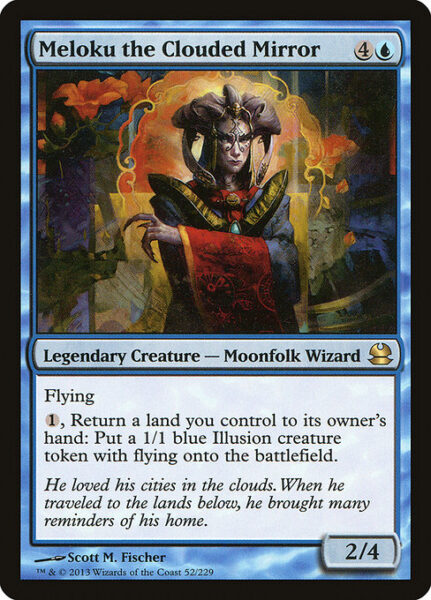
Playing Lands from Hand
In a deck looking to abuse landfall triggers by making multiple land drops in a turn, it can be easy to run out of lands in our hand. This is why we prioritize playing lands from the top of our library and our graveyard, as detailed above. However, we can further ameliorate this difficulty with cards that allow us to repeatedly return lands from the battlefield to our hand, thus ensuring we never miss a land drop. And, like with all good Commander cards, the spells that let us do this further our game plan in other ways too.
Meloku the Clouded Mirror – does it all for us. Every time I read the card, I’m amazed at how well it synergizes with our deck. For a single colorless mana and without tapping, we get a land to our hand and a 1/1 blue Illusion token with flying. Let’s say we have the means to make 3 land drops in a turn, plus a Felidar Retreat and an Emeria Angel. We tap 3 lands, return those lands to our hand, then replay them and get a total of 9 tokens or 6 tokens and 3 +1/+1 counters on our creatures (not each of the tokens made this turn will have all 3 counters, it should be noted). Now, throw in a Field of the Dead. We’re getting 3 Zombies too. Do we have Divine Visitation out? 4/4 Angels please. Purphoros, God of the Forge? Take 18. The card is amazing and also a candidate for one of our finishers.
No, this is a combo…
Mina and Denn, Wildborn – another repeatable way to return a land to our hand, this time at the more restrictive cost of a , but with the added benefit of giving one of our creatures trample. Our Knight of the Reliquary huge, but getting chump blocked? Not anymore.
Tameshi, Reality Architect – this moonfolk wizard (our second such creature, by the way) allows us to return a land to our hand as long as we have an enchantment or artifact in our graveyard to target. We play 11 artifacts and enchantments, including two of our finishers, Purphoros, God of the Forge and Brudiclad, Telchor Engineer. The others are all combo pieces essential to our game plan. If they aren’t in the yard, then we’re probably winning anyway. The card draw is just gravy.
Azorius Chancery, Boros Garrison, Gruul Turf, Izzet Boilerworks, Selesnya Sanctuary, Simic Growth Chamber – otherwise known as bounce lands – they enter tapped, tap for 2 different colors of mana, and make us return a land to our hand as an additional cost. Modern players will know these from Amulet Titan. These lands are great at mana fixing, but are here for two reasons. The first is to give us an additional land in hand to play in order to trigger landfall by returning a land to our hand when they enter the battlefield. The second is to combo with Llanowar Scout or Sakura-Tribe Scout and Retreat to Coralhelm, as explained above. Whenever possible, we want to wait to play these lands until we have set up our combo pieces so as to get maximum value out of what in other decks is their primary drawback.
Oboro, Palace in the Clouds – with its reprinting in Lord of the Rings, the price finally dropped enough that I added it to the deck.
Tutors
Being a combo deck, we want to maximize our chances of finding our pieces and tutors do just that. If we have 5 ways of searching our library for a creature, that effectively gives us 5 additional copies of that creature in our deck. Need a finisher? Let’s tutor up Purphoros, God of the Forge. Need a support piece? Lotus Cobra. Many of our landfall cards are enchantments, so we have a way to find those, too.
Chord of Calling – with the number of tokens we make, we should be able to cast this for X = 6 or more with relative ease.
Eladamri’s Call – one of our best tutors, this lets us search at the end of our opponent’s turn, untap, and play whatever creature we need to close out the game.
Enlightened Tutor – our one tutor that gets us an enchantment or an artifact. We play three enchantment creatures (Purphoros, God of the Forge, Courser of Kruphix, and Dryad of the Ilysian Grove) and one artifact creature (Brudiclad, Telchor Engineer) that we can put on top of our library with this instant.
Primal Command – gives us an answer to noncreature permanents, as well as a way to find a creature.
Worldly Tutor – another instant-speed tutor for the low price of a single , the card goes to the top of our library.
The Lands
I don’t usually devote an entire section to the mana base, but in a deck that wants to abuse landfall triggers as much as this one, it will be useful to discuss our choices.
Fetch Lands
We play all 10 of the original fetch lands (Arid Mesa, Flooded Strand, etc.), plus Fabled Passage. We could run Prismatic Vista, but since we want to use our fetch lands primarily after we have some of our landfall pieces in place, Fabled Passage will routinely do the same thing without costing us a life. We also can’t run every single land that lets us fetch another land, or the deck would be almost all lands or we would run out of targets and whiff.
We play a few other lands that allow us to sacrifice them and search up two lands. Blighted Woodland, Krosan Verge, and Myriad Landscape all function similarly, in that they tap for a colorless but can be sacrificed to let us search up two basic lands and put them on the battlefield tapped. Each one comes with an additional mana cost to do this, but by the time we want to crack these, we should have more than enough mana to work with. Typically, we will want to use their fetch ability only when we’re ready to go off and win the game. In a pinch, though, they can fix our mana.
Finally, we play one land destruction land that doubles as a fetch land: Field of Ruin (we could add Ghost Quarter and Demolition Field as well). The main reason we are playing this over something like Strip Mine or Wasteland (besides the cost of these, as I discuss here) is that we can play Field of Ruin and use it the same turn to get a second landfall trigger.
Bounce Lands
As discussed above, these lands have the drawback of returning a land we control to our hand when they enter the battlefield. For our deck, though, this is more of a benefit, as it gives us another land to play on the turn we play the bounce land, assuming we have our pieces in place. Like Blighted Woodland and the other lands that let us search up two basics, we will ideally play our bounce lands during the late game when we can get maximum value out of them.
Utility Lands
The world is our oyster here and I recommend playing the lands that best suit your meta, except for one: Field of the Dead. This land most definitely should be in your 99, as it functions as an alternate win condition in many situations. It synergizes extremely well with all of our other win conditions and combo pieces. Vesuva (and Thespian’s Stage if you want another such land) is largely in the deck to copy Field of the Dead, though it can just as easily copy one of our other utility lands if we want to go the land destruction route, for instance. It can also help fix any mana issues we have in the early game, particularly since we will more than likely be able to return Vesuva to our hand at some point.
Reliquary Tower and Yavimaya, Cradle of Growth are flex spots. We don’t have that many ways of drawing a ton of cards and so Reliquary Tower just may not do enough compared to other lands we could put in its place. The green Urborg, Tomb of Yawgmoth feels like an auto-include, but in a 4-color deck not looking to benefit from a critical mass of forests, it’s not necessary and there are other lands that can support our game plan or address our weaknesses. Boseiju, Who Endures gives us some flexible removal for problematic permanents (looking at you, Blood Moon).
Lands We Should Consider Playing
Mystic Sanctuary – another great land to abuse with our bounce lands in the late game. If you want to fine-tune this deck to be as competitive as possible, I would include this land. For anyone who has played against it in Modern, though, the game play it leads to once it’s online (and it’s fetchable, so it’s easy to find), can be tedious and no fun, to say the least. I play it in my Mono Blue Control deck, but don’t want to jam it in every deck with enough islands to support it for the above reason.
Scavenger Grounds – every Commander deck should have some graveyard hate. The chief drawback, of course, is that it exiles all graveyards and so can nerf our strategy as well. However, if your meta has a lot of reanimation shenanigans or other ways to abuse the yard, find a spot for this utility land.
Tolaria West – iterations of this deck have played Summoner’s Pact, which is at least one good reason to play this land.
Valakut, the Molten Pinnacle – another land that would give us an alternate win condition. We could easily run Scapeshift and tweak our mana base to be mountain heavy so as to abuse this Modern staple.
Why No Triomes? Why No Cycle Lands? Why No Horizon Canopy Lands?
Which lands to play is one of the key balancing acts of this deck, and a case could be made for any of these lands finding a spot in the 99, particularly given our ability to recur lands from the graveyard. There is certainly a lot of value to be had here if we can draw a card off of one of these lands and then replay it. With the Horizon Canopy lands, in particular, this is repeated card advantage. The simple reason why these aren’t included is we can’t play all the lands and choices have to be made. Let’s get into why I made the choices I did.
Basic Land Restrictions
Of the 6 instants and sorceries that search up lands from our library and put them directly into play, 3 restrict us to searching up basics. Similarly, besides the 10 original fetch lands, the other 5 lands we play that allow us to search up a land restrict us to basics, as well. We play 11 basic lands to help ensure we don’t whiff on one of these fetches. Furthermore, folding to Blood Moon feels bad, so having enough basics in a 4-color deck takes up a lot of the land slots (a quarter of our lands, in fact).
Tapped or Untapped Lands
Triomes are great at mana fixing, but they enter the battlefield tapped no matter what. We already play bounce lands that enter tapped, plus Myriad Landscape and Krosan Verge. Playing even more tapped lands will increase our odds of playing behind curve the entire game. Even in a format like Commander, this can be the difference between winning and losing. Along these same lines, despite how much mana we can make in any given turn, the turns when we really go off require all the mana we can make and we are still often wishing we had more. Fetching up an untapped dual land on these turns is crucial. This is why we prioritize the shock lands over the triomes.
The same logic applies to the cycle lands that tap for two mana. As to the cycle lands that only tap for a single color, well, in a 4-color deck, a tapped land that doesn’t produce more than 1 mana just doesn’t cut it.
Horizon Canopy Lands
These lands make the most sense, given that they enter the battlefield untapped, tap for two different colors, and we sacrifice them from the battlefield to draw a card, rather than cycle them from our hand. The life loss of tapping for 1 of 2 colors can be significant, but I do think it’s worth trying them out to see if they’re worth it. Including them would come at the cost of either a utility land, 1 or 2 basics, or trimming a combo piece. This is certainly doable. Let me know in the comments if you run these lands in your Omnath, Locus of Creation deck.
Flex Spots
There are 5 cards outside of our combo or finishers that could be switched out without watering down the synergies of the deck. Fierce Guardianship, Deflecting Swat, and Teferi’s Protection all help keep our board state intact. A case could be made for including Teferi’s Protection in any deck that runs white, but I think it really shines in a combo deck like this one. We rely almost equally on our creatures, be they token or nontoken, and our enchantments. Because of this, rebuilding from a sweeper that hits both (Farewell, for example) can be very challenging. Protecting them when our opponent thinks they got us can be game over. Similarly, our commander is such an important piece of our strategy that the recently reprinted free spells feel like an auto-include, as well. They are also great at keeping a key combo piece other than our commander around.
Hanna, Ship’s Navigator gives us the ability to rebuild from a sweeper or from targeted removal that knocked out one of our landfall enchantments. Remember also that we play 3 enchantment creatures and 1 artifact creature that we can recur with the artificer.
Elesh Norn, Mother of Machines is the final card I could see cutting. She is no doubt extra busted in a deck like ours, while also hating on many other strategies (my Bant Blink deck, for instance). However, doubling up our tokens and counters will often just be win-more. Given that we play no sweepers or spot removal (outside of Banefire), cutting Mom might be the correct, albeit less fun, decision.
Cards that Could Make the Cut
I’ve been playing this deck for a couple of years now and earlier iterations included some of the following cards, while others further our strategy but haven’t made the cut yet. However, all could be considered for the deck, depending on your meta, preference, and/or collection:
| Woodland Bellower | |
| Flagstones of Trokair | |
| Ghost Quarter | |
| Prismatic Vista | |
| Thespian’s Stage | |
| Valakut, the Molten Pinnacle |
Per usual, none of these cards were cut because they were bad. Some, like Karametra, God of Harvests and Vivien, Monsters’ Advocate, were cut before I ever truly got to test them. In some cases, new cards were printed which seem better, while in other cases, older, more expensive cards were reprinted, dropping their price, which has led me to make changes. Of the above cards, a few are worth discussing in more detail, in case you’re looking to fill out your 99.
Murasa Rootgrazer – a sweet, cheap creature that does a lot of what we want. I play it in my budget version of this deck.
Qasali Pridemage – gives us a removal spell for problematic permanents on a body, letting us tutor the cat wizard up if an artifact or enchantment is ruining our fun.
Idyllic Tutor – a way to search up one of our enchantment pieces that was cut for Enlightened Tutor after its most recent reprint. A case could be made that both deserve to be in the deck.
Scapeshift – even without Valakut, the Molten Pinnacle to make this card an “I-win-the-game card,” the value we could get out of it is insane with the right board state. Float all our mana and follow it up with Splendid Reclamation and we may just have the most fun that’s ever been had in all of Magic.
Wrenn and Seven – such a sweet card that synergizes extremely well in our deck. That it’s a Planeswalker and likely to die before we untap is the chief reason it got the axe (pun intended). 5 mana is a lot, as well. If I remember correctly, I replaced them with Tameshi, Reality Architect.
Woodland Bellower – one of my favorite cards, I play it in other decks, which was one reason I cut it. Also, a 6-mana, restrictive tutor is a little slow, even if it can get us a Lotus Cobra or Knight of the Reliquary.
No Targeted Removal?
We’re really rolling the dice on this one and, as you can see, I’ve played removal in previous iterations of the deck. In French Commander, the lack of removal is felt a lot more than in traditional Commander, but it’s probably correct to be less greedy and just make room for a couple of sweepers and/or counter magic. We could trim a few combo pieces to free up space, or cut out one of our win conditions, such as Hedron Crab and Ruin Crab. Scute Swarm is an easy cut, though it is a card that can win in the late game without much support. Tireless Tracker is great for drawing us cards, but if we’re lacking an answer for Elesh Norn, Mother of Machines in our deck to draw in to, perhaps it’s best just to cut the human scout. Uro, Titan of Nature’s Wrath could also go without greatly impacting the power of the deck. Writing this section is even convincing me to make some of these changes, but I’ll keep the deck max greedy for now…
Notable Landfall Cards Absent from the Deck
As important as our landfall cards are, we need to address those that didn’t make the cut and the reasons why. Here are some of the more powerful landfall cards not in our deck:
| Nesting Dragon | |
| Titania, Protector of Argoth | |
| Phylath, World Sculptor | |
| Rampaging Baloths | |
| Avenger of Zendikar | |
| Omnath, Locus of Rage |
These are some very, very powerful landfall cards (Titania, Protector of Argoth isn’t technically a landfall card, but she fits our strategy), so why aren’t they in the deck? The answer for your Omnath, Locus of Creation deck is they probably should be, though making room for them would cut back on some of our combo pieces or finishers. However, they are powerful enough on their own to function as finishers and so it would be easy enough to slot them in. For my Omnath deck, I am mostly trying to play cards that I don’t play elsewhere. I have a Lord Windgrace deck that I built before Omnath, Locus of Creation was printed and it plays many of the same support cards with the above landfall creatures as its finishers. For the sake of variety, and so that it doesn’t just feel like I’m playing the same deck with a different commander, I chose to go a different route with this deck, while keeping landfall the central part of its strategy. Furthermore, I also have an elemental tribal deck that plays many of these same creatures, as most happen to be elementals. Be on the lookout for articles about both in the near future!
Ideal Hand and Game Play
Being a combo deck, our ideal hand will have one of each of our pieces – a landfall card, a way to play multiple lands in a turn (whether via a creature or one of our instants/sorceries), and a way to play lands from the top of our library or graveyard. Having a finisher is nice, but not necessary, as we will need many turns to get to the point where we need one.
More specifically, Lotus Cobra is one of the cards we love to see in our opening 7. Exploration is our best turn 1 play. Having these two cards with enough lands and action to abuse them is the balance we’re trying to strike. Retreat to Coralhelm or Tireless Tracker are great follow-up plays that allow us to find more action. An early Purphoros, God of the Forge can immediately make us the target at the table, but it’s a hard-to-deal-with threat and so may not matter. Of all the pieces of our combo, I would put primacy on landfall cards in our opening 7, as we run so many lands that even without ways to make multiple land drops, we will get value out of them. On the flipside of this, if we have a lot of ways to make land drops and no landfall cards, we will be left with a lot of mana and nothing to do with it, having gotten little to know value out of our extra land drops. Many of our finishers will be immediate targets, so if we play them early without the support pieces, they will just get destroyed or exiled before we can go off with them.
As to game play, as I have mentioned above, saving fetch lands and bounce lands for the late game is ideal, but not at the cost of missing land drops or being color screwed. We have ways of getting cards back from the graveyard and other bounce lands to draw into or search up. Our instants, sorceries, and lands that fetch us 2 or 3 lands are best used after we’ve set up our landfall cards. We don’t want to use Skyshroud Claim on turn 4 to ramp or color fix unless we absolutely have to, or have something bigger and better to do with all of that mana (or redundant ways to search up lands).
We have the potential for extremely fast starts, but for the most part this is a midrange, grindy deck that is looking to combo off in the late game and win in 1 or 2 turns.
Weaknesses
As with any combo deck, the risk is not drawing the necessary pieces or our opponent answering our most powerful piece. In particular, not having any landfall cards on the battlefield will often leave us with underpowered creatures and a lot of mana. Secondly, we play a lot of lands and can easily flood out. Omnath draws us a card, which can help us find action, but if we keep a land-heavy opening 7, there is more of a risk of flooding out than in other decks. Finally, we don’t play much interaction. If our opponent is playing an aggressive deck or a must-answer commander, it is quite possible we will get run over before we get going.
Conclusion
This deck is one of the most fun decks I have ever played. I’ve had some of the most busted turns of any I’ve had playing Magic. There are so many cool synergies and triggers once you get going that it can even be hard to keep up with them all. It is a more complex deck than others, both because it is 4 colors and because the combo requires at least 3 pieces. However, it is super rewarding and powerful. Let me know in the comments what you think of the deck! What landfall cards am I forgetting? How do you abuse Omnath, Locus of Creation? What other support pieces should be considered? Am I going to get max punished for my greedy lack of removal?
